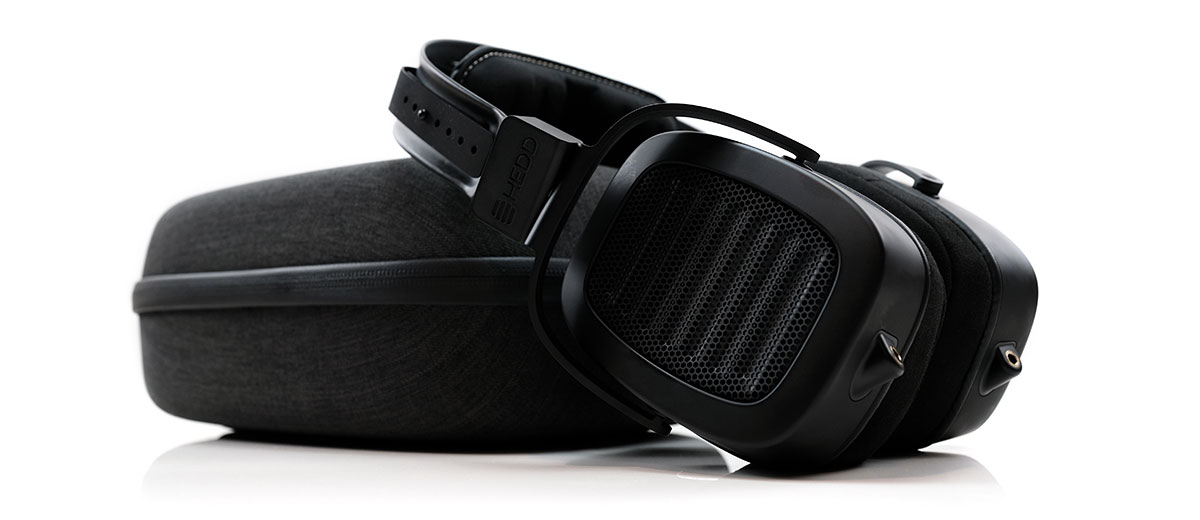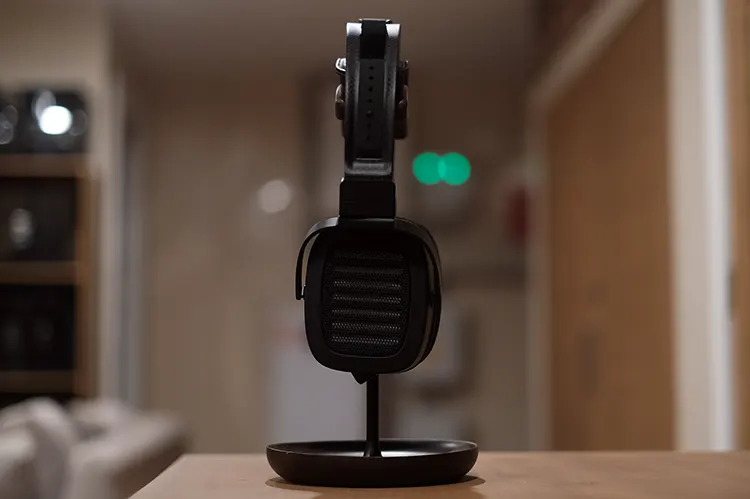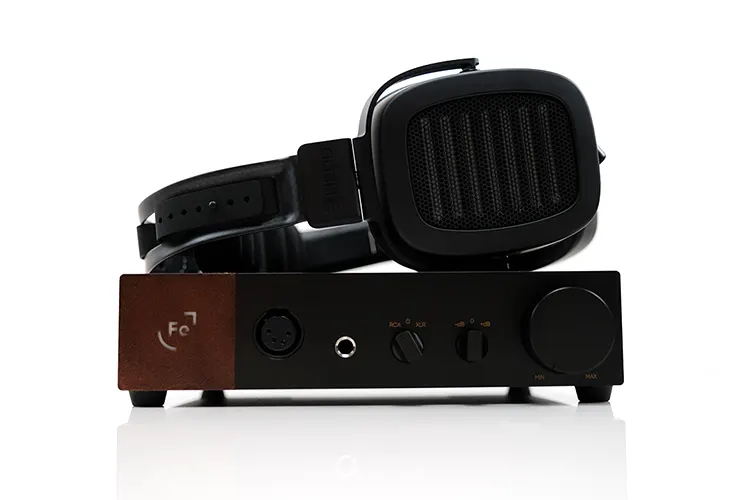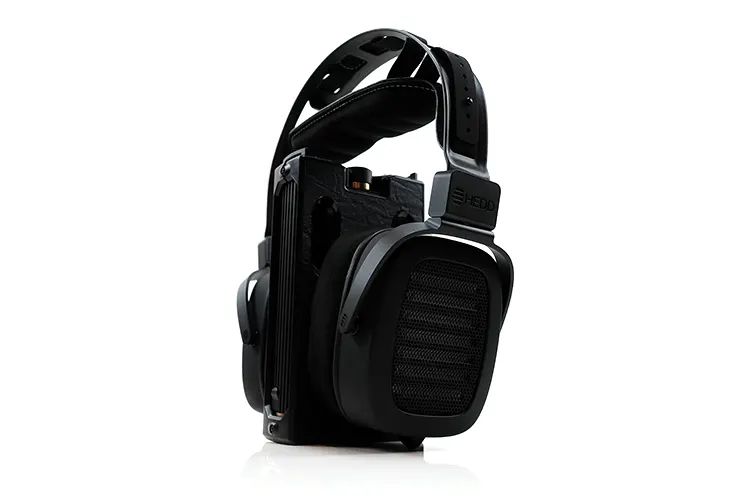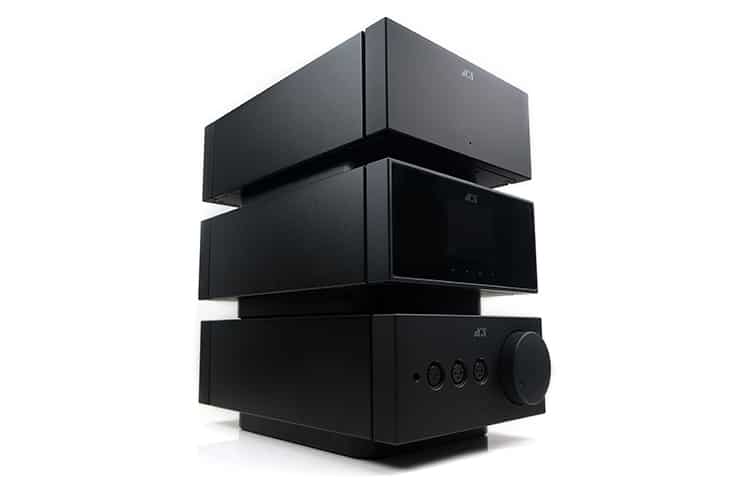Sound Impressions
The following sound impressions of the HEDD Audio HEDDphone TWO GT were completed using a mix of the dCS Lina Headphone amplifier, Network DAC, and Master Clock as well as the Ferrum WANDLA GSE with the OOR/Hypsos stack.
Summary
The HEDDphone TWO GT delivers what I would define as a ‘universal’ sound signature or one that will appeal to a wider audience with a more dynamic tuning than the non-GT, combined with speed and impressive resolution.
There are a few noticeable tuning traits with the GT. Perhaps the most obvious is the ‘stiffened lows’ with a punchier character and an improved sub-bass response over the previous HEDDphone versions.
It’s the type of lows that, whilst not being excessive or near basshead territory, has more of a pleasing level of physically, making it a more appealing choice for lovers of recordings underpinned by a strong rhythmic response such as EDM and modern R’n’B/soul.
Now, I see the term warmer being mentioned as a trait of the HEDDphone TWO GT. To be honest, I am not sure I agree with that blanket statement. I would argue that this version has power, contrast, and dynamics, making it a more exciting presentation.
If anything, the non-GT is more rounded through the mids. Much of that has to do with a stronger treble presence from the HEDDphone TWO GT tuning, particularly in the upper treble that’s being picked up as a harmonic overtone by an enhanced upper mids around 3-5k.
That creates more tonal contrast than what has come before. Thus, vocal and percussion imaging in this region is enhanced, but the note body is a little lighter in body and not as rich and intimate as the non-GT equivalent.
That has its advantages, with note definition sounding excellent. All that AMT driver speed flows beautifully, so complex recordings exhibit excellent clarity. It’s not a huge holographic soundstage, but the precision imaging makes the most of what it has, particularly on the X-axis (width).
Frequency Response
The major change in the HEDDphone TWO GT FR is an elevated bass shelf from 20Hz to around 200Hz by around 3-5 dB, with particular mid-bass emphasis from 80Hz to 150Hz.
The depth and punch are now more palatable. I would argue more for the mid-bass punch, though the sub-bass response helps ensure the fundamental frequency resonates nicely on lower-register instruments alongside that punch.
This is not a basshead headphone, but it does introduce some necessary balance in its presentation for modern pop and EDM performances that need that weight and slam to sound credible. I would call it tasteful rather than overindulgent.
I also hear a slight drop in presence from 200 Hz to around 80 Hz relative to the non-GT version. It does not have quite the same thickness and immediacy in this region, with a more typical strong fundamental and a bit more contrast coming into the note timbre.
From 1-2k up to around a noticeable 5k peak, the HEDDphone TWO GT exhibits more elevation than the non-GT and the original HEDDphone’s tuning.
This cuts both ways because, on the one hand, the perception of space and vocal/instrumental separation is stronger. The clarity and precision will seem subjectively better.
On the other hand, I find the timbre and note body in the upper mids have a little more contrast and slightly less weight compared to the non-GT’s thicker, more intimate midrange sound.
The treble tuning on the HEDDphone TWO GT has been given a bit of lift, but more so around 8-10K than the lower 6- 8 K region.
Compared to the Non-GT from 6-10k and beyond, it has more energy. However, it’s not a peaky sound at all. This is a cleaner tone with more sparkle and a stronger harmonic influence on midrange timbre in general.
Staging & Dynamics
Coming from the non-GT version, the HEDDphone TWO GT sounds more spacious, with improved height and depth. IMHO, this pivots closer to the original HEDDphone’s more ethereal staging quality but with superior depth and vocal presence.
The fundamental frequency is there, so the power from the HEDDphone TWO GT lows is the best from this range of headphones so far.
What I find is a slight lack of midrange body compared to the non-GT through the mids. I can’t fault anything below 500Hz, but the slightly dipped lower-mid range presence just pulls back the body a bit from instruments in this register.
Thus, vocals are more forward-sounding but not quite as ‘big-sounding’ as the non-GT presentation, if that makes sense.
Arguably, the note weight is neutral with more contrast, so I found my ear split between two directions: the improved bass response and the taller-sounding and airier upper-mids performance.
The imaging and speed are excellent. I would expect nothing less from this AMT driver, and it has been a trait throughout their HEDDphone range.
Perhaps more so with this version, given its upper treble has been given a bit of a bump. Height or headroom is a thing now, where it wasn’t quite as apparent in the previous edition.
Just be careful when source matching with the HEDDphone TWO GT. A source with decent Vrms output will provide a noticeable lift in bass impact and staging width. Reduce that or switch to an amp not known for strong bass, and the performance can sound a little flat.
Synergy
Efficiency
The HEDD Audio HEDDphone TWO GT is rated at 41Ω impedance with an SPL of 88 dB/mW. Compared to the previous models, there is only a tiny deviation on paper, with the original rated at 42Ω and 87dB /mW and the 2nd gen HEDDphone TWO at 41Ω and 89 dB /mW.
However, when testing with a balanced Ferrum WANDLA GSE DAC and OOR/HYPSIOS setup, I perceived the HEDDphone TWO GT as a little quieter than the previous two models on the same volume level.
As with the previous models, the HEDDphone TWO GT is not that efficient and does need a decent amount of power to sound optimal.
That is not to say smaller, more compact, or portable devices should not be considered in terms of driving capability. After all, HEDD Audio has included a 4.4mm termination as stock on one of the cables, and modern DAPs and portable amps are packing a lot more grunt than they used to a few years back.
Portable Pairings
I found the HEDDphone TWO GT to scale with portable devices offering around 1W upwards and with decent Vrms headroom.
For example, the iBasso DX340/AMP15 pairing can output up to 1200mW balanced, and it sounds resolving but a little flat on the lows compared to more powerful desktop amplifiers.
When connected via its DC12V input, the DX340 will increase the voltage headroom from 8V to 12V, giving you a maximum output power rating of 2150mW balanced, which sounds far more dynamic on the HEDDphone TWO GT than just the battery alone.
Without the DC12V, the DX340 sounds flatter than the DX320 MAX Ti in the lows. With the DC12V, you get plenty of punch and more dynamics with highs that are smoother sounding than the MAX’s.
If you feel there is too much contrast in the HEDDphone TWO GT, then the DX340 is more suitable. However, for competitive dynamics, you will be tied to the DC12V cable.
Another good example of voltage headroom is Cayin’s Hyper mode in the C9ii and the N6iii. With the 700mW E203 card, the HEDDphone TWO GT sounds flat and lacking in soundstage depth and snap.
With Hyper mode and the additional 200 mW of output power, you get a far meatier and vibrant sound, but compared to the DX340/DC12V, it’s not as airy or spacious sounding.
You need to switch to the C9ii’s hyper mode to get an addictive combination of tonal density and soundstage from the HEDDphone TWO GT. With the C9ii, you are more or less getting desktop performance from the HEDDphone TWO GT.
This pairing sounds snappy in solid-state mode and thick and rich in texture in tube mode. The tube mode is perfect for those wanting to squeeze out any possible upper-mid sibilance from the GT performance whilst retaining a powerful low-end.
Desktop Pairings
I tried 2 stacked desktop SS systems with the HEDDphone TWO GT. This included the Ferrum WANDLA GSE/OOR/HYPSOS stack, the dCS Lina headphone amplifier, Network DAC, and Master clock. For tubes, I went with the Cayin HA-300MK2 with a Holo Audio Spring DAC 2 behind it.
Every system brought out something special in the HEDDphone TWO GT performance. However, if it’s all about optimizing that enhanced power on the lows, I would opt for the solid state amps, specifically the dCS Lina stack.
The Ferrum and dCS line setups had more authority on the lows than the Cayin. They also sound more precise, faster, and can better ‘propel’ the HEDDphone TWO GT’s snappier mid-bass response.
Of the two, the Lina stack extended deeper, sounding more refined in the highs with more textured detail in vocal performances. The Ferrum sounded more ‘walled in’, drier, and not so spacious with a shallower low-end in default mode.
You can add impressive space and more holographic imaging on the GT via the WANDLA GSE DSP options and even create a richer sound than the dCS with the Tube mode.
However, I would lay off the Impact+ mode on the GSE as it creates too much bloom in the GT bass and upsets the balance for my tastes.
The HA-300MK2 pairing is what you want for vocal performances. It pulls the GT a little closer to the non-GT performance with a creamier vocal texture and beautiful width.
Of the three amps, the GT sounded the smoothest from the HA-300MK2, but it lacks that punch and power, which might be why you are getting the GT in the first place.

